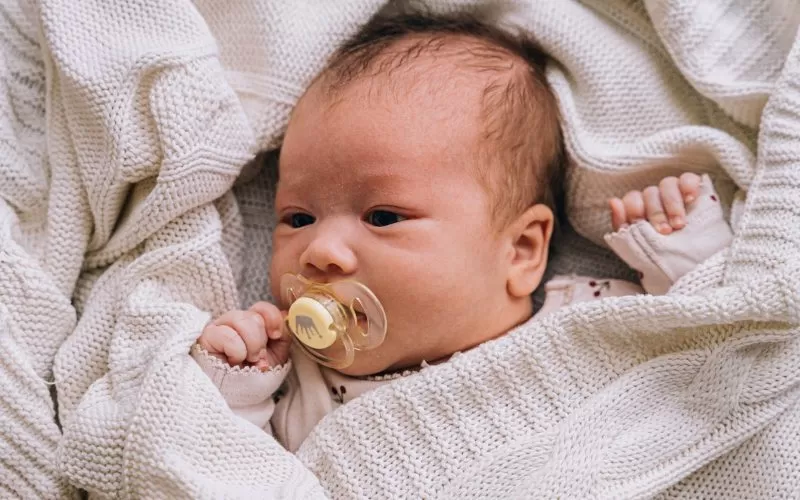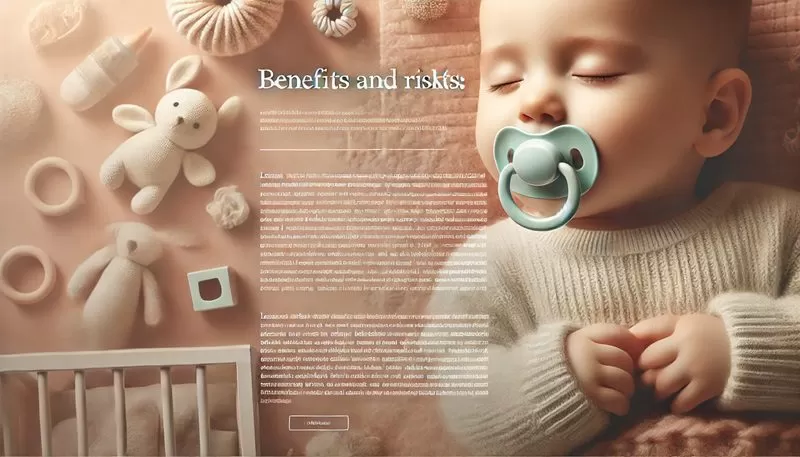Table of Contents
Pacifiers Benefits and Risks
Pacifiers have been a popular soothing tool for babies for generations. They offer quick relief to fussy infants and help aid sleep. The benefits of pacifiers are well-documented, such as providing comfort and reducing the risk of sudden infant death syndrome (SIDS). However, there are also risks with prolonged use. These risks include potential dental health issues and dependency. This comprehensive guide will explore the pros and cons of pacifiers. It will also offer tips on when and how to use them effectively. Additionally, you’ll find some high-quality pacifier options from ebabymart to help you make an informed decision for your baby’s needs.
Pacifiers have been a staple in baby care for generations, offering a sense of comfort and security to newborns. However, it is essential to weigh the pros and cons carefully to ensure they are used appropriately. According to the Mayo Clinic’s guide on the benefits and risks of pacifiers, using them correctly can prevent certain oral health issues while still offering soothing benefits. This comprehensive resource provides valuable insights for parents looking to make informed decisions.
Sleep deprivation is one of the biggest challenges new parents face, especially when trying to manage their baby’s sleep routine. While pacifiers can sometimes help soothe babies to sleep, it’s important to have a plan in place for handling your own sleep needs. If you’re struggling with sleepless nights, check out our detailed guide on How to Deal With Sleep Deprivation After Baby, where you’ll find practical tips and strategies to help you get the rest you need.
What Are the Benefits of Using a Pacifier?

Pacifiers can be incredibly helpful for both parents and babies, especially in the early months of life. They serve as a quick solution for calming fussy babies, providing a sense of security and satisfaction. Here are some of the primary benefits of using pacifiers:
1. Soothing Effect
A pacifier can quickly calm a crying or overstimulated baby. Many infants have a natural need to suck, and pacifiers provide an effective way to satisfy this reflex without feeding. When a baby is upset or restless, offering a pacifier can help divert their attention and offer them immediate comfort.
2. Aid in Sleep
Many babies find it easier to fall asleep and stay asleep when they have a pacifier. The act of sucking can be soothing, encouraging them to settle down more quickly during naptime or bedtime. Moreover, studies have shown that pacifiers can help babies self-soothe during brief nighttime awakenings, allowing both the baby and parents to enjoy better sleep.
3. Reduced Risk of SIDS
One of the most significant benefits of pacifiers is their potential to reduce the risk of SIDS. Research suggests that using a pacifier during naps and bedtime can lower the incidence of sudden infant death syndrome. While the exact reasons behind this are not entirely understood, it’s believed that pacifiers may help keep the airway open and ensure babies don’t sleep too deeply, which can contribute to a safer sleep environment.
4. Encourages the Sucking Reflex
For babies with a strong need to suck, pacifiers can be a useful tool to satisfy this urge without relying solely on feeding. This can be particularly helpful for bottle-fed babies who may seek the comfort of sucking even after their feeding needs are met.
For a reliable and high-quality option, check out our Orthodontic Pacifier, designed to promote healthy oral development while soothing your baby.
Diaper blowouts and leaks can be a common challenge for parents, but with the right products and techniques, managing these messes becomes much easier. Ensuring a proper fit with high-quality diapers is crucial in preventing leaks. Additionally, using diaper covers or inserts can provide an extra layer of protection. For those particularly tricky nighttime leaks, overnight diapers can offer longer-lasting coverage. You can also try using diaper liners for added convenience when cleaning up after a blowout. For more tips on preventing leaks, check out our guide on Managing Diaper Blowouts and Leaks and explore solutions designed to keep your baby comfortable and dry.
Risks and Drawbacks of Pacifiers

While pacifiers offer several advantages, they also come with potential risks, particularly if they are used improperly or for too long. It’s essential for parents to be aware of these risks to make informed choices about their baby’s pacifier use.
1. Dental Problems
Prolonged pacifier use, especially after the age of two, can lead to dental issues such as misalignment of the teeth or bite problems. The constant sucking pressure can alter the natural alignment of the teeth, potentially causing an overbite or other issues that may require orthodontic intervention later in childhood.
2. Nipple Confusion
Introducing a pacifier too early, particularly for breastfeeding infants, may cause nipple confusion. Some babies may struggle to distinguish between the pacifier and the breast, leading to challenges in latching and breastfeeding effectively. To minimize this risk, it’s recommended to wait until breastfeeding is well-established before introducing a pacifier.
3. Dependency
While pacifiers can be incredibly soothing for babies, some infants may become overly reliant on them for comfort. This can make it difficult to wean them off the pacifier later on, especially when it’s time to transition to other self-soothing methods.
If you’re concerned about potential risks, our Silicone Pacifier is a great alternative. It’s gentle on your baby’s mouth, easy to clean, and minimizes the risk of infection or irritation, offering a safe option for your baby’s comfort.
While pacifiers can offer soothing benefits for newborns, it’s essential for parents to stay informed about other common newborn health concerns. For instance, jaundice is a condition that can affect many newborns, leading to yellowing of the skin and eyes due to excess bilirubin in the blood. If you’re concerned about your baby’s health, it’s important to understand the Jaundice in Newborns – Symptoms, Causes, and Treatment, as early detection and care can prevent complications.
Pros and Cons of Using a Pacifier

To help you make an informed decision, let’s break down the pros and cons of using a pacifier in a simple, digestible format:
Pros:
- Soothes and calms fussy babies: A pacifier provides immediate comfort when your baby is upset, overstimulated, or anxious.
- Promotes better sleep: Many babies fall asleep faster and sleep more soundly with a pacifier, reducing the need for constant rocking or feeding.
- Reduces the risk of SIDS: Research shows that pacifier use during sleep can reduce the likelihood of sudden infant death syndrome (SIDS).
Cons:
- Potential impact on dental health: Prolonged pacifier use beyond infancy can cause misalignment of teeth, increasing the need for orthodontic care later in life.
- Possible breastfeeding challenges: Early introduction of a pacifier may interfere with breastfeeding if the baby becomes confused between the breast and the pacifier.
- Dependency: Some babies may become overly dependent on the pacifier for comfort, making it challenging to wean them off when the time comes.
Pacifiers: To Use or Not to Use?
With so much information on both the benefits and risks, you may still wonder, Pacifiers: To Use or Not to Use? The answer largely depends on your baby’s needs and your parenting preferences. Pacifiers can be a helpful tool when used responsibly and in moderation. However, it’s essential to monitor your baby’s usage and gradually wean them off the pacifier as they grow older to avoid long-term complications.
For those who decide to use a pacifier, our Natural Rubber Pacifier is an eco-friendly option that provides a safe, comfortable experience for your baby. Made from non-toxic materials, it is designed to support natural oral development while being kind to the environment.
Recommendations for the Use of Pacifiers

When considering pacifiers for your baby, it’s essential to follow best practices to maximize the benefits while minimizing the risks. Here are some key recommendations for the use of pacifiers:
1. Wait Until Breastfeeding Is Well-Established
If you’re breastfeeding, wait until your baby is about 3 to 4 weeks old before introducing a pacifier. This helps avoid nipple confusion and ensures that breastfeeding is well-established before adding a pacifier into the mix. Once breastfeeding is going smoothly, pacifiers can be a helpful tool for soothing your baby.
2. Use During Naps and Bedtime
Offering a pacifier during naps and bedtime can help reduce the risk of SIDS. However, it’s important to ensure that the pacifier is safe and well-suited for sleep. Our Orthodontic Pacifier is a great option, designed to promote proper oral development while providing comfort during sleep.
3. Avoid Force-Feeding the Pacifier
Not all babies need or want a pacifier, and that’s perfectly okay. If your baby doesn’t seem interested in the pacifier, don’t push it. Some infants may naturally prefer other forms of soothing, such as cuddling or sucking on their fingers, and forcing a pacifier may create unnecessary dependency.
4. Clean Pacifiers Regularly
To prevent bacterial buildup, it’s important to clean your baby’s pacifier frequently, especially after it’s been dropped on the floor or exposed to dirt. Pacifiers should be sterilized regularly to minimize the risk of infection or irritation. Our Silicone Pacifier is easy to clean and can be quickly sterilized, making it a hygienic option for your baby.
5. Wean Off the Pacifier by Age Two
By the time your baby reaches age two, it’s a good idea to start gradually reducing pacifier use. Extended pacifier use beyond this age can lead to dental issues and interfere with speech development. Gradually limiting pacifier use can make the weaning process easier for both you and your baby.
When traveling with a baby, having the right gear is essential to ensure a smooth and stress-free experience. From compact strollers that are easy to fold and store to travel-friendly diaper bags with multiple compartments, having the right essentials can make all the difference. Don’t forget about items like portable baby seats and lightweight carriers that offer comfort and convenience while on the go. For more tips on How to travel with a baby, and the gear you need and the must-have gear, check out our comprehensive guide that will help make your journey as easy as possible.
Making the Decision: Pacifiers: To Use or Not to Use?
Ultimately, the choice of whether or not to use a pacifier is a personal one. By weighing the pros and cons of using a pacifier, as well as considering your baby’s unique needs, you can make the best decision for your family. Remember, pacifiers are a tool—not a necessity—and can be used effectively with the right approach.
For those looking to introduce a pacifier, [your store] offers a variety of safe and high-quality pacifiers to suit every baby’s preference. From the Orthodontic Pacifier for oral development to the Natural Rubber Pacifier for eco-conscious parents, we’ve got you covered.

